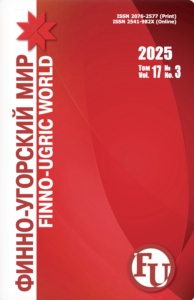Linguistic geography as the basis of Area Studies of the Mordovian languages
Levina Maria Z.,
Candidate Sc. {Philology}, Associate Professor, Department of Mordovian Languages, Ogarev Mordovia State University (Saransk, Russia), lev.mariya@mail.ru
The article considers the basic principles of modern linguistic geography, which on the basis of a comparative study of isoglosses makes it possible to receive important information for retrospective study of the history of languages and dialects, to establish their links and the relative chronology of the development of various linguistic phenomena.
Keywords: dialectological atlas; geographical distribution; area; isogloss; dialects and sub dialects of the Moksha language; morphological and lexical traits; grammar characteristics.
1. Avanesov, R. I. (1965), On two aspects of dialectology object, Common Slavic Linguistic Atlas (research materials), Moscow: Nauka, p. 24–35.
2. Agafonova, N. A. and Ryabov, I. N. (2013), Dialectological atlas as a result Erzya dialect research methods of linguistic geography, Finno-Ugric world, № 2, p. 48–53.
3. Batalova, P. M. (1982), Areal studies of the eastern Finno-Ugric languages (Komi), Moscow: Nauka.
4. Bubrikh, D. V., Belyakov, A. A., Punzhina, A. V. (1997), Dialectological atlas of Ka re lian language, Helsinki: Finno-Ugric Society.
5. Bubrikh, D. V. (1936), On the work on Mordvinian dialect atlas, Revolution and writing, № 2, p. 38–41.
6. Bubrikh, D. V. (1935), Program on collecting material for dialect atlas of Mordovian (Erzya and Moksha), Languages, Saransk: Mordgiz.
7. Ermushkin, G. I. (1984), Areal studies on the eastern Finno-Ugric languages (Erzya-Mordvin language), Moscow: Nauka.
8. Kovedyaeva, E. I. (1987), Areal studies on the eastern Finno-Ugric languages: the Mari language, Moscow: Nauka.
9. Levina, M. Z. (2014), Dialectology of the Moksha language, Saransk: Mordovia University Press.
10. Levina, M. Z. (2008), Dialects of the Moksha language in lingua-geographical aspect: a tutorial, Saransk: Mordovia University Press.
11. Lizanets, P. N. (1989), Principles of atlas design of Hungarian dialects of Transcarpathia area, Questions lexicology Finno-Ugric languages, Saransk, p. 19–35.
12. Nasibullin, R. Sh., Maksimov, S. A., Semenov, V. G., Otstavnova, G. V. (2009), Dialectological atlas of the Udmurt language. Maps and comments, Vol. 1, Izhevsk: NITs “Regular and Chaotic Dynamics”.
13. Nasibullin, R. Sh., Maksimov, S. A., Semenov, V. G., Otstavnova, G. V. (2010), Dialectological atlas Udmurt language. Maps and comments, Vol. 2.
14. Serebrennikov, B. A. (1973), Methods of lingua-geographical research, General Linguistics. Methods of linguistic research, Moscow: Nauka, p. 120–167.
15. Sreznevsky, I. I. (1851), Remarks on the materials for the geography of the Russian language, Bulletin of the Imperial Russian Geographical Society for 1851, Part 1. Book 1–2, Dep. V, Saint Petersburg.
16. Feoktistov, A. P. and Paasonens, H. (1990), Dialects of Mordovian languages, Mordwinisches Wörterbuch, Bd. 1, Helsinki: Suomalais-ugrilainen seura, p. LX–LXXXVI.
17. Feoktistov, A. P. (2002), On the study of dialects of the Finno-Ugric languages and methods of field areal linguistics, Study Press of the Moscow Hungarian College, Moscow: Valang, p. 318–329.
18. Tsygankin, D. V. and Bibin, M. T. (2002), Linguistic Atlas of Moksha and Erzya dialects, Saransk: Typography “Krashyj Ok tyabr”.
19. Tsygankin, D. V. (2015), Mordovian languages in the view of Finno-Ugric Studies linguist, monograph, Saransk: Mordovia University Press.
20. Tsygankin, D. V. (2000), Mordovian languages in the view of linguist, Saransk.






















